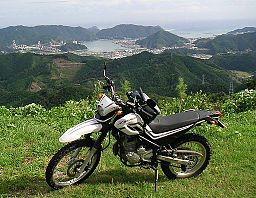The Japanese Serow
Introduction Serow live in Taiwan as well as Japan.The serowserow belongs to the CapricornisCapricornis family. They are half goat and half antelope.antelope. It has a smaller cousin called a goral.goral. Because it has hoofs, it is a bovid.bovid.
Serow live in Taiwan as well as Japan.The serowserow belongs to the CapricornisCapricornis family. They are half goat and half antelope.antelope. It has a smaller cousin called a goral.goral. Because it has hoofs, it is a bovid.bovid.
Habitat
The serow lives in Asia in Indonesia,Indonesia, Japan, China, TaiwanTaiwan and the Himalayas. In Japan they live mainly on Honshu.Honshu.
Appearance

Serow are 1.5m tall and they weigh 50 to 110 kg. Its tail is 8 to 16cm. Serow have black to whitish bushy fur. Their fur gets lighter in the summer. The serow has pointed ears and they have little beards.
Diet The serow is eating shoots.The serow eats leaves, shoots and acorns. They feed at morning and afternoon time.
The serow is eating shoots.The serow eats leaves, shoots and acorns. They feed at morning and afternoon time.
Movement Serow are good climbers in the mountains.The serow like to be by themselves or in family groups. They have glands in their hoofs to mark their territory.territory. They are good climbers and they make tracks on the mountains.
Serow are good climbers in the mountains.The serow like to be by themselves or in family groups. They have glands in their hoofs to mark their territory.territory. They are good climbers and they make tracks on the mountains.
Life Cycle The mum serow with her fawn.The serow mate in October and November. They have one to two babies called fawns after seven months. They drink their mum’s milk until they are five to six months old. They can live until they are twenty.
The mum serow with her fawn.The serow mate in October and November. They have one to two babies called fawns after seven months. They drink their mum’s milk until they are five to six months old. They can live until they are twenty.
Enemies
It was hunted by poachers until it was nearly extinctextinct in the middle of the 20th century. Now it is protected and it is a nationalnational symbolsymbol of Japan so they are not endangered anymore. In fact, farmers and foresters get sick of them.
Conclusion The serow is a national symbol of Japan and this motorbike is named after it. The serow is a strange animal because it is half goat and half antelope. It is the national symbol of Japan. They have got black to whitish bushy fur. They eat leaves, acorns and shoots and they make tracks when they climb. A baby serow is called a fawn like a deer. The serow is not endangered anymore, so I might see one when I go to Japan.
The serow is a national symbol of Japan and this motorbike is named after it. The serow is a strange animal because it is half goat and half antelope. It is the national symbol of Japan. They have got black to whitish bushy fur. They eat leaves, acorns and shoots and they make tracks when they climb. A baby serow is called a fawn like a deer. The serow is not endangered anymore, so I might see one when I go to Japan.
| antelope | a kind of deer | poachers | hunters without permission |
| fawn |
a baby deer |
shoots | new bits on a plant |
| glands | organs in a human or animal body that send messages | territory | an area where an animal can find food and mates |
Bibliography
Mrs Nunweek's Fact File on Japanese Serow
Animals of the World, edited by Felicity Forster, published by Anness Publishers in 2008
By Kiel
{chronoconnectivity5}L2L_NF2_Feedback{/chronoconnectivity5}